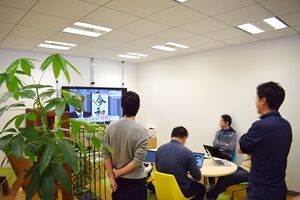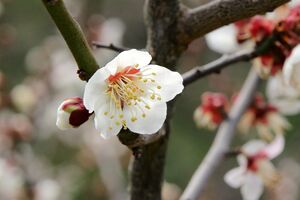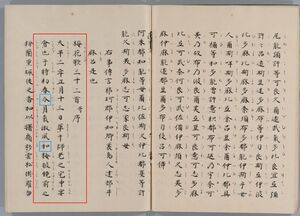عهد رِيْوا
| Reiwa令和 | |||
|---|---|---|---|
| 1 May 2019 – present | |||
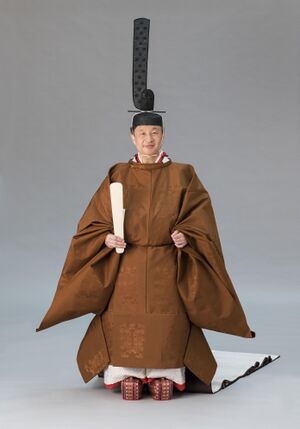 Emperor Naruhito of the Reiwa era (2019) | |||
| المكان | Japan | ||
| ويضم | |||
| العاهل | ناروهيتو | ||
| الأحداث الرئيسية |
| ||
| |||
| جزء من سلسلة عن |
| تاريخ اليابان |
|---|
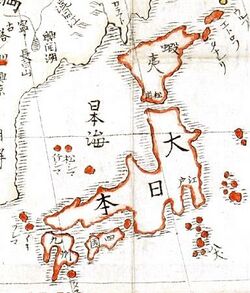 |

رِيْوا Reiwa (يابانية: 令和, تـُنطق [ɾeːwa] (![]() استمع) أو [ɾeꜜːwa][1][2]) is the current era of Japan's official calendar. It began on 1 May 2019, the day on which Emperor Akihito's elder son, Naruhito, ascended the throne as the 126th Emperor of Japan. The day before, Emperor Akihito abdicated the Chrysanthemum Throne, marking the end of the Heisei era. The year 2019 corresponds with Heisei 31 from 1 January through 30 April, and with Reiwa 1 (令和元年, Reiwa gannen, 'the base year of Reiwa') from 1 May.[3] The Ministry of Foreign Affairs of Japan explained the meaning of Reiwa to be "beautiful harmony".[4]
استمع) أو [ɾeꜜːwa][1][2]) is the current era of Japan's official calendar. It began on 1 May 2019, the day on which Emperor Akihito's elder son, Naruhito, ascended the throne as the 126th Emperor of Japan. The day before, Emperor Akihito abdicated the Chrysanthemum Throne, marking the end of the Heisei era. The year 2019 corresponds with Heisei 31 from 1 January through 30 April, and with Reiwa 1 (令和元年, Reiwa gannen, 'the base year of Reiwa') from 1 May.[3] The Ministry of Foreign Affairs of Japan explained the meaning of Reiwa to be "beautiful harmony".[4]
خلفية
الإعلان
The Japanese government on 1 April 2019 announced the name during a live televised press conference, as Chief Cabinet Secretary Yoshihide Suga traditionally revealed the kanji calligraphy on a board. The Prime Minister Shinzō Abe said that Reiwa represents "a culture being born and nurtured by people coming together beautifully".
Name selection
A shortlist of names for the new era was drawn up by a nine-member expert panel comprising seven men and two women with the cabinet selecting the final name from the shortlist.[5] The nine experts were:[6]
- Midori Miyazaki (宮崎緑) – professor at Chiba University of Commerce
- Itsurō Terada (寺田逸郎) – former chief justice of the Supreme Court of Japan
- Shinya Yamanaka (山中伸弥) – Nobel prize-winning stem-cell scientist, professor at Kyoto University
- Mariko Hayashi (林真理子) – screenwriter and novelist
- Sadayuki Sakakibara (榊原定征) – former chairman of the Japan Business Federation
- Kaoru Kamata (鎌田薫) – trustee and president of Waseda University
- Kōjirō Shiraishi (白石興二郎) – president of the Japan Newspaper Publishers and Editors Association
- Ryōichi Ueda (上田良一) – president of the Japan Broadcasting Corporation
- Yoshio Ōkubo (大久保好男) – president of Nippon Television Holdings
The day after the announcement, the government revealed that the other candidate names under consideration had been Eikō (英弘[7]), Kyūka[8] (久化), Kōshi or Kōji[7][9] (広至), Banna or Banwa[7][9] (万和), and Banpo or Banhō[7][9] (万保),[10] three of which were sourced from two Japanese works, the Kojiki and the Nihon Shoki.[11] Official pronunciations and meanings of these names were not released, although the reading of Eikō was leaked; the other readings are speculative.[9]
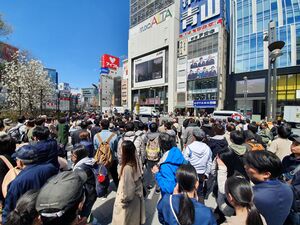
الأصل والمعنى
The kanji characters for Reiwa are derived from the Man'yōshū, an eighth-century (Nara period) anthology of waka poetry. The kotobagaki (headnote) attached to a group of 32 poems (815–846) in Volume 5 of the collection, composed on the occasion of a poetic gathering to view the plum blossoms, reads as follows:[بحاجة لمصدر]
Classical Japanese translation (kanbun kundoku): 時に、初春の令月にして、気淑く風和ぎ、梅は鏡前の粉を披き、蘭は珮後の香を薫す。
Toki ni, shoshun no reigetsu ni shite, kiyoku kaze yawaragi, ume wa kyōzen no ko o hiraki, ran wa haigo no kō o kaorasu.[13]
English translation:
It was in new spring, in a fair (rei) month,
When the air was clear and the wind a gentle (wa) breeze.
Plum flowers blossomed a beauty's charming white
And the fragrance of the orchids was their sweet perfume.
The Japanese Foreign Ministry provided an English-language interpretation of Reiwa as "beautiful harmony", to dispel reports that "Rei" (令) here is translated as "command" or "order"[14][4][15] – which are the significantly more common meanings of the character, especially so in both modern Japanese and Chinese.[15][16] The Foreign Ministry also noted that "beautiful harmony" is rather an explanation than an official translation or a legally binding interpretation.[15]
Prior to and naturally irrespective of the era announcement, within the context of the Chinese essay in the Man'yōshū from which the excerpt is cited, the expression 令月 (which characters constitute the word reigetsu in modern Japanese) has generally been academically translated or interpreted as "wonderful" or "good (Japanese: yoi) month" in published scholarly works, such as by Alexander Vovin in English as wonderful month in his 2011 commentary and translation of Book 5,[17] or by Susumu Nakanishi in Japanese as yoi tsuki (好い月) in his commentary and translation into modern Japanese that was published in 1978.[18] In addition, following the announcement of Reiwa in 2019, Susumu Nakanishi advocated for understanding the character rei (令) of the era name through the help of the Japanese word uruwashii (うるわしい, fair (of sight, weather), beautiful, fine (also of mood) etc.), stressing that in the traditional dictionaries (such as Erya or the Kangxi Dictionary), the word 令 is explained with the word 善.[19] Nakanishi criticized the understanding of the rei (令) in Reiwa as Japanese utsukushii (美しい, generally meaning "beautiful"), which was propagated by then-Prime Minister Shinzo Abe, pointing out that neither the etymology nor the exact sense are appropriate.[19]
الجـِدة
"Reiwa" marks the first Japanese era name with characters that were taken from Japanese literature instead of classic Chinese literature.[20][21][22][23]
Robert Campbell, director-general of National Institute of Japanese Literature in Tokyo, provided an official televised interpretation to NHK, regarding the characters based on the poem,[مطلوب توضيح] noting that "Rei" is an auspicious wave of energy of the plum blossoms carried by the wind, and "Wa", the general character of peace and tranquility.[24]
Accordingly, the name marks the 248th era name designated in Japanese history.[25] While the "wa" character 和 has been used in 19 previous era names, the "rei" character 令 has never appeared before.[26] The character appeared in a proposed era name in 1864—Reitoku (令徳)—that the ruling Tokugawa shogunate rejected, as it could be interpreted as the emperor commanding (rei) the Tokugawa.[27]
On the other hand, according to Masaaki Tatsumi (辰巳正明), professor of Japanese literature, and Masaharu Mizukami (水上雅晴), professor of Chinese philosophy, interviewed by the Asahi Shimbun shortly after the announcement was made, the phrase has an earlier source in ancient Chinese literature dating back to the second century AD, on which the Man'yōshū usage is allegedly based:[28]
於是仲春令月,時和氣清;原隰鬱茂,百草茲榮。
Yú shì zhòng chūn lìng yuè, shí hé qì qīng; yuán xí yù mào, bǎi cǎo zī róng.
Then comes young spring, in a fine month,
When the wind is mild and the air clear.
Plains and swamps are overgrown with verdure
And the hundred grasses become rank and thick.— translation by Liu Wu-chi، An Introduction to Chinese Literature (1990)[29]
Implementation
Currency
According to the Japan Mint, all coins with the new era name will be released by October 2019. It takes three months to make preparations such as creating molds in order to input text or pictures. The Mint will prioritize creating 100- and 500-yen coins due to their high mintage and circulation, with an anticipated release by the end of July 2019.[30][needs update]
التكنولوجيا
Anticipating the coming of the new era, the Unicode Consortium reserved a code point (U+32FF ㋿ square era name reiwa)[31] in September 2018 for a new glyph which will combine half-width versions of Reiwa's kanji, 令 and 和, into a single character; similar code points exist for earlier era names, including Shōwa (U+337C ㍼ square era name syouwa) and Heisei (U+337B ㍻ square era name heisei) periods.[32] The resulting new version of Unicode, 12.1.0, was released on 7 May 2019.[33][34]
The Microsoft Windows update KB4469068 included support for the new era.[35]
الأحداث
On 19 November 2019, Shinzo Abe became the longest-serving prime minister of Japan and surpassed the previous 2,883-day record of Katsura Tarō.[36] Abe also beat Eisaku Satō's record of 2,798 consecutive days on 23 August 2020.[37] He resigned for health reasons in September 2020 and was succeeded by Yoshihide Suga.[38]
In early 2020, Japan began to suffer from the COVID-19 pandemic as several countries reported a significant increase in cases by March 2020.[39] Japan and other countries donated masks, medical equipment, and money to China.[40][مطلوب مصدر أفضل]
In June 2020, Fugaku was declared the most powerful supercomputer in the world with a performance of 415.53 PFLOPS.[41] Fugaku also ranked first place in computational methods performance for industrial use, artificial intelligence applications, and big data analytics. It was co-developed by the RIKEN research institute and Fujitsu.[42]
A year later than originally scheduled, the 2020 Tokyo Olympics were held in the summer of 2021.
In September 2021, Suga announced he would not stand in the Liberal Democratic Party leadership election, effectively ending his term as prime minister. He was succeeded by Fumio Kishida who took office as prime minister on 4 October 2021. Kishida was elected leader of the ruling Liberal Democratic Party (LDP) a week prior. He was officially confirmed as the country's 100th prime minister following a parliamentary vote.[43]
In March 2022, a strong offshore earthquake near Fukushima killed 4, injured hundreds, and damaged the Shinkansen line in Tohoku.
In July 2022, the former prime minister Shinzo Abe was assassinated by Tetsuya Yamagami in Nara.[44] By comparison, Japan had only 10 gun related deaths from 2017 to 2021 and 1 gun fatality in 2021.[45]
In 2022, the Russian invasion of Ukraine caused Japan to join sanctions against Russia.[46] Japan was the first Asian country to exert pressure on Russia.[47]
On December 16, 2022, the Second Kishida Cabinet announced a departure from Japan's defense-oriented policy by acquiring counterstrike capabilities and a defense budget increase to 2% of GDP by 2027.[48] This comes amidst growing security concerns over China, North Korea and Russia.[48] This will make Japan the 3rd largest defense-spender (¥43 trillion ($315 billion) after the United States and China.[49]
جدول التحويل
To convert any Gregorian calendar year since 2019 to Japanese calendar year in Reiwa era, subtract 2018 from the year in question.
| Reiwa | 1 | 2 | 3 | 4 | 5 |
|---|---|---|---|---|---|
| I | II | III | IV | V | |
| AD | 2019 | 2020 | 2021 | 2022 | 2023 |
| MMXIX | MMXX | MMXXI | MMXXII | MMXXIII |
انظر أيضاً
المراجع
- ^ Takishima, Masako (July 2019). 令和のアクセント (PDF). The NHK Monthly Report on Broadcast Research (in اليابانية). 69 (7): 89. ISSN 0288-0008.
- ^ "新元号「令和(れいわ)」 出典は万葉集" (in اليابانية). 1 April 2019. Archived from the original on 4 April 2019. Retrieved 1 April 2019.
- ^ "New Japanese imperial era Reiwa takes name from ancient poetry". Reuters. 1 April 2019. Archived from the original on 1 April 2019. Retrieved 1 April 2019.
- ^ أ ب "Government says Reiwa translates as 'beautiful harmony'". The Asahi Shimbun. 3 April 2019. Archived from the original on 1 May 2019. Retrieved 1 May 2019.
- ^ Rich, Motoko (1 April 2019). "Japan's New Era Gets a Name, but No One Can Agree What It Means". The New York Times. Archived from the original on 1 April 2019. Retrieved 1 April 2019.
- ^ "「元号」有識者懇メンバー9人発表 ". Mainichi Shimbun (in اليابانية). 1 April 2019. Archived from the original on 1 April 2019. Retrieved 1 April 2019.
- ^ أ ب ت ث "新元号 6原案中4つは 「英弘」「広至」「万和」「万保」". NHK News Web (in اليابانية). 2 April 2019. Archived from the original on 6 April 2019. Retrieved 7 April 2019.
- ^ "Banna, Banpo, Eiko, Koshi and Kyuka: The Japan eras that could have been, beaten out by Reiwa". The Japan Times. 3 April 2019. Archived from the original on 11 April 2019. Retrieved 11 April 2019.
- ^ أ ب ت ث Baseel, Casey (3 April 2019). "4 era names the gov't rejected before deciding on Reiwa". Japan Today. Archived from the original on 6 April 2019. Retrieved 6 April 2019.
- ^ "新元号 6案すべて判明 「令和」考案は中西進氏か". NHK News Web (in اليابانية). 2 April 2019. Archived from the original on 2 April 2019. Retrieved 2 April 2019.
- ^ "「令和」考案は中西進氏 古事記・日本書紀含め、3案が国書典拠" (in اليابانية). Archived from the original on 3 April 2019. Retrieved 3 April 2019.
- ^ "真字萬葉集卷第五雜歌0815". Archived from the original on 1 April 2019. Retrieved 1 April 2019.
天平二年正月十三日,萃于帥老大伴旅人之宅,申宴會也。于時,初春令月,氣淑風和。梅披鏡前之粉,蘭薰珮後之香。加以,曙嶺移雲,松掛羅而傾蓋,夕岫結霧,鳥封穀而迷林。庭舞新蝶,空歸故鴈。於是,蓋天坐地,促膝飛觴。忘言一室之裏,開衿煙霞之外。淡然自放,快然自足。若非翰苑,何以攄情。請紀落梅之篇,古今夫何異矣。宜賦園梅,聊成短詠。
- ^ "新元号「令和」 首相談話「花を大きく咲かせたい」". Nikkei (in اليابانية). 1 April 2019. Archived from the original on 1 April 2019. Retrieved 1 April 2019.
- ^ "Govt.: 'Reiwa' means 'beautiful harmony'". NHK World. 3 April 2019. Archived from the original on 1 May 2019. Retrieved 1 May 2019.
- ^ أ ب ت "Japan assures world that Reiwa is all about 'beautiful harmony' and has nothing to do with 'command'". The Japan Times. 3 April 2019. Archived from the original on 3 April 2019. Retrieved 3 April 2019.
- ^ The Associated Press (3 April 2019). "Government says Reiwa translates as 'beautiful harmony'". Asahi Shimbun. Archived from the original on 1 May 2019. Retrieved 27 June 2019.
- ^ Vovin, Alexander (2011). Man'yōshū: Book 5, a new English translation containing the original text, kana transliteration, romanization, glossing and commentary (in الإنجليزية). Folkestone: Global Oriental. ISBN 978-1-906876-20-3.
- ^ Nakanishi, Susumu (8 August 1978). Man'yōshū Zen'yakuchū Genbun-tsuki (Ichi) 万葉集 全訳注原文付(一) [Man'yōshū: a Full Translation and Commentary Containing the Original Text (Part 1)] (in اليابانية). Kodansha Bunko. ISBN 978-4061313828.
- ^ أ ب "「令」に一番近い日本語は「うるわしい」 「令和」の考案者と目される国文学者が意味を解説". Daily Shincho (in اليابانية). 17 May 2019. Retrieved 22 November 2020.
- ^ McCurry, Justin. "Reiwa: how Japan's new era name is breaking tradition".
- ^ Sim, Walter. "Sign of the times: Japan picks Reiwa to succeed Heisei as new imperial era from May 1".
- ^ Osaki, Tomohiro. "Reiwa: Japan reveals name of new era ahead of Emperor's abdication".[مطلوب مصدر أفضل]
- ^ "新元号は「令和」(れいわ) 万葉集典拠、国書由来は初". Asahi News Digital (in اليابانية). 1 April 2019. Archived from the original on 1 April 2019. Retrieved 2 April 2019.
- ^ "Japanese Literature Expert on New Era Name". NHK World Japan. 1 April 2019. Archived from the original on 2 April 2019. Retrieved 2 April 2019.
- ^ "Japan announces "Reiwa" as new era name to begin under new emperor". Xinhua. 1 April 2019. Archived from the original on 1 April 2019. Retrieved 1 April 2019.
- ^ "Japan's govt. chooses 'Reiwa' as new era name". NHK World Japan. 1 April 2019. Archived from the original on 2 April 2019. Retrieved 1 April 2019.
- ^ The Associated Press (3 April 2019). "Government says Reiwa translates as 'beautiful harmony'". Asahi Shimbun. Archived from the original on 1 May 2019. Retrieved 27 June 2019.
- ^ Ozawa, Satoshi (1 April 2019). "「日本が困難な時、万葉集がはやる」 令和は歴史的転換". Asahi News Digital (in اليابانية). Archived from the original on 1 April 2019. Retrieved 2 April 2019.
- ^ Liu, Wu-chi (1990). An Introduction to Chinese Literature. Westport, Connecticut: Greenwood Press of Greenwood Publishing Group. p. 54. ISBN 0-313-26703-0.
- ^ "「令和」の硬貨はいつ発行される?免許証、書類はどうなる… | ページ 2". bizSPA!フレッシュ (in اليابانية). 2 April 2019. Archived from the original on 3 April 2019. Retrieved 3 April 2019.
- ^ Lunde, Ken (1 April 2019). "Adobe-Japan1-7 Published!". CJK Type Blog. Adobe. Archived from the original on 2 April 2019. Retrieved 2 April 2019.
- ^ "New Japanese Era". The Unicode Blog. Unicode Consortium. 6 September 2018. Archived from the original on 1 April 2019. Retrieved 1 April 2019.
- ^ "Unicode Version 12.1 released in support of the Reiwa Era". Unicode Consortium. Archived from the original on 7 May 2019. Retrieved 9 May 2019.
- ^ "Unicode 12.1.0". The Unicode Consortium. Archived from the original on 2 April 2019. Retrieved 2 April 2019.
- ^ "Summary of new Japanese era Windows updates - KB4469068". support.microsoft.com. Archived from the original on 30 July 2020. Retrieved 17 August 2020.
- ^ Harding, Robin (20 November 2019). "Shinzo Abe becomes Japan's longest-serving prime minister". Financial Times. Retrieved 20 November 2019.
- ^ Yamaguchi, Mari (24 August 2020). "Japan's PM sets mark for days in office amid health concerns". Associated Press. Retrieved 24 August 2020.
- ^ "Yoshihide Suga officially named as Japan's new Prime Minister, replacing Shinzo Abe". 16 September 2020.
- ^ "WHO Director-General's opening remarks at the media briefing on COVID-19—11 March 2020". World Health Organization. 20 March 2020. Retrieved 11 March 2020.
- ^ 日本民间捐100万口罩驰援武汉. Guancha (in Chinese (China)). 26 January 2020. Retrieved 29 January 2020.
- ^ "Supercomputer Fugaku - Supercomputer Fugaku, A64FX 48C 2.2GHz, Tofu interconnect D". TOP500 Supercomputer Sites. Retrieved 22 June 2020.
- ^ "Japan's Fugaku rated world's fastest supercomputer". NHK World. Archived from the original on 23 June 2020. Retrieved 23 June 2020.
- ^ "Fumio Kishida takes office as Japan's new Prime Minister". 4 October 2021.
- ^ "Japan's former PM Abe Shinzo shot, confirmed dead | NHK WORLD-JAPAN News". NHK WORLD (in الإنجليزية). Archived from the original on 8 July 2022. Retrieved 8 July 2022.
- ^ "Shooting of Former Prime Minister Abe a Shock to Japan, Which Saw Just One Gun Fatality in 2021". Nippon.com. 8 July 2022. Archived from the original on 8 July 2022.
- ^ "Japan unveils new sanctions on Russians, bans refinery equipment exports". Reuters (in الإنجليزية). 2022-03-08. Retrieved 2022-03-16.
- ^ Martin Fritz (April 28, 2022). "Japan edges from pacifism to more robust defense stance". Deutsche Welle. Archived from the original on July 30, 2022.
{{cite web}}:|archive-date=/|archive-url=timestamp mismatch; يوليو 9, 2022 suggested (help) - ^ أ ب Jesse Johnson, Gabriel Dominguez (16 December 2022). "Japan approves major defense overhaul in dramatic policy shift". The Japan Times. Archived from the original on December 16, 2022.
- ^ Jennifer Lind. "Japan Steps Up". Foreign Affairs. Archived from the original on 23 September 2022.
وصلات خارجية
| سبقه Heisei (平成) |
Era of Japan Reiwa (令和) 1 May 2019 – present |
آخر شاغل للمنصب |
- CS1 uses اليابانية-language script (ja)
- CS1 اليابانية-language sources (ja)
- كل المقالات بدون مراجع موثوقة
- كل المقالات بدون مراجع موثوقة from April 2019
- CS1 uses الصينية-language script (zh)
- CS1 Chinese (China)-language sources (zh-cn)
- CS1 errors: archive-url
- Short description matches Wikidata
- Articles with unsourced statements from April 2019
- جميع الصفحات التي تحتاج تنظيف
- مقالات بالمعرفة تحتاج توضيح from April 2019
- Articles containing صينية-language text
- Wikipedia articles in need of updating from July 2020
- All Wikipedia articles in need of updating
- كل المقالات بدون مراجع موثوقة from June 2023
- 2019 establishments in Japan
- Reiwa period
- Japanese eras
- 2010s neologisms
- 2019 neologisms
- 2019 in Japan
- 2020s in Japan
- 2019 introductions
